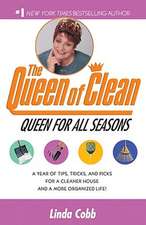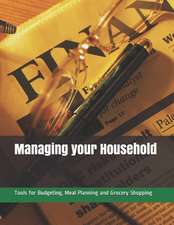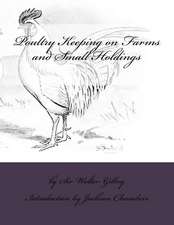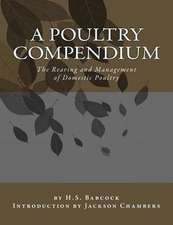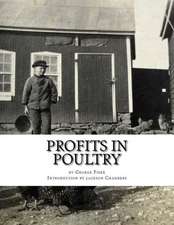Talking Dirty Laundry with the Queen of Clean
Autor Linda C. Cobben Limba Engleză Paperback – 31 dec 2000
DOWN WITH LAUNDRY DRUDGERY! LET THE QUEEN OF CLEAN® MAKE WASH DAY LOADS OF FUN!
Once upon a time, in a world fraught with shrinking jeans, dry-cleaning debacles, and endangered delicates, laundry was a dreaded chore. Then one happy day, the Queen of Clean® put an end to the vicious washand-dry cycle -- with her all-new collection of ingenious tips and natural solutions for stress-free washing, ironing, sorting, and stain-busting!Let the Queen show you how to:
- sort laundry like a pro
- remove spots, stains, scorch marks, and odors
- soften hard water-and save clothes from a dull, gray fate
- make your own fabric softener sheets in a snap
- say good-bye to pink socks, with a foolproof colorfastness test
- line-dry clothes without hanger lumps or clothespin marks
- decipher those fabric care symbols on clothing tags
- get the scoop on home dry-cleaning kits
- discover the secrets to lint-free drying-and quick fixes for when tissues, crayons, and other foreign bodies take a spin in the dryer
lemon juice • meat tenderizer • WD-40 • lubricant • salt • shaving cream...and more!
Whether you turn around family-sized wash loads seven days a week, air your dirty laundry at the local laundromat, or are among the seriously "laundry challenged," consult the Queen for no-nonsense advice -- and fabulous results!
Preț: 80.88 lei
Nou
Puncte Express: 121
Preț estimativ în valută:
15.48€ • 16.86$ • 13.04£
15.48€ • 16.86$ • 13.04£
Carte disponibilă
Livrare economică 02-16 aprilie
Preluare comenzi: 021 569.72.76
Specificații
ISBN-13: 9780743418324
ISBN-10: 0743418328
Pagini: 192
Dimensiuni: 136 x 211 x 12 mm
Greutate: 0.22 kg
Editura: Simon&Schuster
ISBN-10: 0743418328
Pagini: 192
Dimensiuni: 136 x 211 x 12 mm
Greutate: 0.22 kg
Editura: Simon&Schuster
Cuprins
Contents Foreword
2. Drying: How to Succeed Without Really Trying
3. Getting the Hang of Line Drying
4. Laundry Detergents and Great Alternatives
5. Be a Spot Hot Shot!
6. Bringing Out the Big Guns
7. Stain Removers That Are Hiding in Your Cupboard
8. Bleach 101: Whiter Whites, Brighter Brights
9. Fabric Softeners -- The Soft Sell
10. The Hard Truth About Water Softeners
11. Starch and Sizing
12. Cry Me a River -- The Color Ran!
13. You Can Be a Rescuer of Things That Reek!
14. Care Labels: What Are They Good For?
15. Doing the Laundry Sorting Boogie
16. Know When to Hold'Em, Know When to Fold'Em
17. Taking the Dread Out of Dry Cleaning
18. The Dirt on Home Dry-Cleaning Kits
19. Final Thoughts on Dry Cleaning
20. Ironing and Ironing Boards: Taking the Heat
22. Perspiration Stains: They're the Pits!
23. Socks and Panty Hose
24. Getting in the Swim
25. Hats and Handbags
26. Ties: Don't Let Them Tie You in Knots
27. Snap, Zip, and Hook! (No, It's Not a New Breakfast Cereal!)
28. Beads and Sequins: Let's Face the Music and Dance
29. Furs: Real and Synthetic
30. Sheepskin
31. Table Linens32. Let the Light Shine: Cleaning Lampshades
33. Slipcovers
34. Don't Throw in the Towel!
35. Window Treatments
36. Bedtime
37. Preserving Your Wedding Gown
38. Cleaning Guide for Fabric Types
A to Z Palace Spot and Stain Removal Guide
Resource Guide
Index
Your Personal Tips and Hints
Part I -- THE BASICS
1. Care and Control of the Washing Machine2. Drying: How to Succeed Without Really Trying
3. Getting the Hang of Line Drying
4. Laundry Detergents and Great Alternatives
5. Be a Spot Hot Shot!
6. Bringing Out the Big Guns
7. Stain Removers That Are Hiding in Your Cupboard
8. Bleach 101: Whiter Whites, Brighter Brights
9. Fabric Softeners -- The Soft Sell
10. The Hard Truth About Water Softeners
11. Starch and Sizing
12. Cry Me a River -- The Color Ran!
13. You Can Be a Rescuer of Things That Reek!
14. Care Labels: What Are They Good For?
15. Doing the Laundry Sorting Boogie
16. Know When to Hold'Em, Know When to Fold'Em
17. Taking the Dread Out of Dry Cleaning
18. The Dirt on Home Dry-Cleaning Kits
19. Final Thoughts on Dry Cleaning
20. Ironing and Ironing Boards: Taking the Heat
Part II -- PALACE PREDICAMENTS
21. Work Clothes22. Perspiration Stains: They're the Pits!
23. Socks and Panty Hose
24. Getting in the Swim
25. Hats and Handbags
26. Ties: Don't Let Them Tie You in Knots
27. Snap, Zip, and Hook! (No, It's Not a New Breakfast Cereal!)
28. Beads and Sequins: Let's Face the Music and Dance
29. Furs: Real and Synthetic
30. Sheepskin
31. Table Linens32. Let the Light Shine: Cleaning Lampshades
33. Slipcovers
34. Don't Throw in the Towel!
35. Window Treatments
36. Bedtime
37. Preserving Your Wedding Gown
38. Cleaning Guide for Fabric Types
A to Z Palace Spot and Stain Removal Guide
Resource Guide
Index
Your Personal Tips and Hints
Recenzii
People MagazineLinda Cobb, the self-styled Queen of Clean®, sweeps into the big time with spotless timing for a book on dirt....Talking Dirty with the Queen of Clean®...has certainly cleaned up.
New York PostThere's no stain Linda Cobb can't tame.
The Herald (Seattle)No stain has beaten Cobb yet, and she has tried and tested almost everything......
The Arizona RepublicThere isn't any stain or cleaning problem for which Cobb doesn't have a solution....
Scott PasmoreNews Anchor, Good Morning ArizonaLipstick on my collar, ring around the collar? Are you kidding! Since talking with the Queen of Clean® my life has never been so clean!
Cathy BlytheHost, "Problems ℜSolutions," KFOR Radio, Lincoln, NebraskaI am a huge fan of Linda Cobb, the absolutely undisputed Queen of Clean®. Our listeners love her terrific advice -- and you will too! As a matter of fact, after reading this book, you may even look forward to doing your next load of laundry!
Jana Bommersbachauthor, TV commentator, and Phoenix Magazine columnistIt is comforting and refreshing to know that for once -- not in our state capitals nor in Washington, D.C., not in Hollywood, nor in the boardrooms of large corporations -- dirt is being wiped out. Thank you, Queen of Clean®.
New York PostThere's no stain Linda Cobb can't tame.
The Herald (Seattle)No stain has beaten Cobb yet, and she has tried and tested almost everything......
The Arizona RepublicThere isn't any stain or cleaning problem for which Cobb doesn't have a solution....
Scott PasmoreNews Anchor, Good Morning ArizonaLipstick on my collar, ring around the collar? Are you kidding! Since talking with the Queen of Clean® my life has never been so clean!
Cathy BlytheHost, "Problems ℜSolutions," KFOR Radio, Lincoln, NebraskaI am a huge fan of Linda Cobb, the absolutely undisputed Queen of Clean®. Our listeners love her terrific advice -- and you will too! As a matter of fact, after reading this book, you may even look forward to doing your next load of laundry!
Jana Bommersbachauthor, TV commentator, and Phoenix Magazine columnistIt is comforting and refreshing to know that for once -- not in our state capitals nor in Washington, D.C., not in Hollywood, nor in the boardrooms of large corporations -- dirt is being wiped out. Thank you, Queen of Clean®.
Extras
Chapter One: Care and Control of the Washing Machine How difficult can it be? You add water and detergent, drop in the clothes, select the cycle and walk away. When you come back the clothes are clean. Okay...but have you ever considered how clean your washing machine is after all that hard water and all those dirty clothes?
Your washer needs some TLC from time to time, especially if you have hard water in your area. So if the clothes seem dull and gray, maybe you don't need that new and improved detergent. Maybe all you need to do is clean the washing machine. Here's the easiest way I know.
Fill the washer with hot water. Add 1 quart of chlorine bleach (no detergent, please). Run the washer through the longest wash cycle. When the washer is still wet -- this should be immediately after the bleach cycle -- add 1 quart of white vinegar and run the washer through the same cycle again. This will clean out soap scum and mineral deposits from the spin basket and also from the hoses. If you live in an area with hard water you really need to do this every three months -- otherwise, every six months will do. You'll be amazed at the difference it will make.
If you start to notice little brown, rusty-looking spots on clothes when they come out of the washing machine, well, it probably is rust! Look your spin basket over carefully when this occurs, and check for any chips in the finish. Chipped areas rust and transfer to clothes, and the only way to remedy this problem is to replace the spin basket. Check with your appliance dealer and be sure to get the right basket for your machine. And a word of caution: Take care when using detergent balls or fabric softener balls. They can chip the spin basket with their weight.
For information on removing rust stains from clothes, turn to the spotting section. It's easier than you think.
Quick Clean Method
When you don't have time to give your machine a really thorough clean, just fill the washer with hot water and pour in 1 gallon of white vinegar. Run through the entire wash cycle.
Cleaning the Fabric Softener Dispenser
Clean the automatic fabric softener dispenser every month to 6 weeks to keep it working well and to prevent it from leaving softener stains on clothes. (Liquid softener can leave blue spots on clothes; marks from dryer sheets can look like small grease patches.) To clean the dispenser you first must warm 1 cup of white vinegar (I use the microwave), and pour it into the dispenser as you would softener. Make sure you use warm vinegar, and make sure you do this when the washer is empty. Large pieces of sticky fabric softener will occasionally be flushed out during cleaning, and they could adhere to clothes. Not a pretty sight. I suggest cleaning the fabric softener dispenser when you are cleaning the machine with one of the methods recommended in this chapter.
Cleaning the Bleach Dispenser
It is equally important to keep the bleach dispenser clean. Clean any removable parts by washing with hot water and dishwashing liquid. When you clean the washer with white vinegar, be sure to add some to the bleach dispenser too.
QUICK TIP
If you don't have space for a washer and dryer to sit next to each other, remember that you can buy some very efficient stackable units. Just make sure to measure the area before you buy.
A front-loading washer is definitely a space saver -- the top makes a great work space for spotting clothes. You'll need to protect the top of the washer if you are going to work off it, though. A plastic breadboard is ideal.
Another good feature of front-loading washers is the way they tumble clothes. They generally tumble clothes the way a dryer does, and that's gentler on fabric than agitating. It is also less wobbly when spinning. The downside is that front-loaders generally have a smaller capacity than toploaders, and they're usually not as good at cleaning heavy, ground-in dirt.
There are many top loaders to choose from. Consider your needs carefully. You may want an extra-large capacity washer if you wash large loads of towels and sheets, but do make sure you don't overbuy. It's a waste of money to buy bells and whistles you don't need -- and there's more to go wrong, too!
Give your washing machine plenty of room to vibrate. Allow an inch of space all the way around the machine.
To keep the exterior of your washer and dryer clean and shiny, make sure you apply a coat of Clean Shield® (formerly Invisible Shield®) as soon as you buy your machine. This will put an invisible nonstick finish on the surface that will keep it looking like new. Water will bead up and wipe off, as will detergent and spotters. Re-apply as needed.
Important: If your washer's power cord does not reach the outlet, have the outlet moved or the power cord replaced with a longer one. Absolutely never use an extension cord between the washer's power cord and the outlet. If water touches the connection between the extension cord and the power cord, you could be electrocuted.
Do not install your washer in an unheated garage or utility room. Water that is trapped inside can freeze and severely damage the machine.
One last installation tip: If you are installing a washing machine in a vacation home that is not heated during cold weather, have it drained completely by an appliance service technician before shutting up the home for the winter. Again, trapped water can freeze and damage the machine.
If I can leave you with a final piece of advice concerning washing machines it would be this: NEVER leave home when the washing machine is running. It only takes seconds for a hose to break or a malfunction to occur and that can cause damage and flooding in your home. I cannot tell you how many water damage cleanups we did when I owned my cleaning and disaster restoration company in Michigan. The amount of water that can pour from a small hose is unbelievable. So is the damage that can be done -- not only to things that can be cleaned or replaced but also to precious treasures that can never be saved. It's heartbreaking.
Copyright © 2001 by Linda Cobb
Your washer needs some TLC from time to time, especially if you have hard water in your area. So if the clothes seem dull and gray, maybe you don't need that new and improved detergent. Maybe all you need to do is clean the washing machine. Here's the easiest way I know.
Fill the washer with hot water. Add 1 quart of chlorine bleach (no detergent, please). Run the washer through the longest wash cycle. When the washer is still wet -- this should be immediately after the bleach cycle -- add 1 quart of white vinegar and run the washer through the same cycle again. This will clean out soap scum and mineral deposits from the spin basket and also from the hoses. If you live in an area with hard water you really need to do this every three months -- otherwise, every six months will do. You'll be amazed at the difference it will make.
If you start to notice little brown, rusty-looking spots on clothes when they come out of the washing machine, well, it probably is rust! Look your spin basket over carefully when this occurs, and check for any chips in the finish. Chipped areas rust and transfer to clothes, and the only way to remedy this problem is to replace the spin basket. Check with your appliance dealer and be sure to get the right basket for your machine. And a word of caution: Take care when using detergent balls or fabric softener balls. They can chip the spin basket with their weight.
For information on removing rust stains from clothes, turn to the spotting section. It's easier than you think.
Quick Clean Method
When you don't have time to give your machine a really thorough clean, just fill the washer with hot water and pour in 1 gallon of white vinegar. Run through the entire wash cycle.
Cleaning the Fabric Softener Dispenser
Clean the automatic fabric softener dispenser every month to 6 weeks to keep it working well and to prevent it from leaving softener stains on clothes. (Liquid softener can leave blue spots on clothes; marks from dryer sheets can look like small grease patches.) To clean the dispenser you first must warm 1 cup of white vinegar (I use the microwave), and pour it into the dispenser as you would softener. Make sure you use warm vinegar, and make sure you do this when the washer is empty. Large pieces of sticky fabric softener will occasionally be flushed out during cleaning, and they could adhere to clothes. Not a pretty sight. I suggest cleaning the fabric softener dispenser when you are cleaning the machine with one of the methods recommended in this chapter.
Cleaning the Bleach Dispenser
It is equally important to keep the bleach dispenser clean. Clean any removable parts by washing with hot water and dishwashing liquid. When you clean the washer with white vinegar, be sure to add some to the bleach dispenser too.
QUICK TIP
Use less detergent and you will have less soap buildup onclothes and in the washing machine. Use 1/2 cup of Arm andHammer Washing Soda™ -- and about half the amount of detergentyou would usually use. Adjust this formula by increasing or decreasing detergent per your individual needs.Tips on Buying and Placing a New Washing Machine
If you don't have space for a washer and dryer to sit next to each other, remember that you can buy some very efficient stackable units. Just make sure to measure the area before you buy.
A front-loading washer is definitely a space saver -- the top makes a great work space for spotting clothes. You'll need to protect the top of the washer if you are going to work off it, though. A plastic breadboard is ideal.
Another good feature of front-loading washers is the way they tumble clothes. They generally tumble clothes the way a dryer does, and that's gentler on fabric than agitating. It is also less wobbly when spinning. The downside is that front-loaders generally have a smaller capacity than toploaders, and they're usually not as good at cleaning heavy, ground-in dirt.
There are many top loaders to choose from. Consider your needs carefully. You may want an extra-large capacity washer if you wash large loads of towels and sheets, but do make sure you don't overbuy. It's a waste of money to buy bells and whistles you don't need -- and there's more to go wrong, too!
Give your washing machine plenty of room to vibrate. Allow an inch of space all the way around the machine.
To keep the exterior of your washer and dryer clean and shiny, make sure you apply a coat of Clean Shield® (formerly Invisible Shield®) as soon as you buy your machine. This will put an invisible nonstick finish on the surface that will keep it looking like new. Water will bead up and wipe off, as will detergent and spotters. Re-apply as needed.
Important: If your washer's power cord does not reach the outlet, have the outlet moved or the power cord replaced with a longer one. Absolutely never use an extension cord between the washer's power cord and the outlet. If water touches the connection between the extension cord and the power cord, you could be electrocuted.
Do not install your washer in an unheated garage or utility room. Water that is trapped inside can freeze and severely damage the machine.
One last installation tip: If you are installing a washing machine in a vacation home that is not heated during cold weather, have it drained completely by an appliance service technician before shutting up the home for the winter. Again, trapped water can freeze and damage the machine.
If I can leave you with a final piece of advice concerning washing machines it would be this: NEVER leave home when the washing machine is running. It only takes seconds for a hose to break or a malfunction to occur and that can cause damage and flooding in your home. I cannot tell you how many water damage cleanups we did when I owned my cleaning and disaster restoration company in Michigan. The amount of water that can pour from a small hose is unbelievable. So is the damage that can be done -- not only to things that can be cleaned or replaced but also to precious treasures that can never be saved. It's heartbreaking.
Copyright © 2001 by Linda Cobb
Notă biografică
Previously the owner of a cleaning and disaster-restoration business in Michigan, dealing with the aftermath of fires and floods, Linda Cobb started sharing her cleaning tips in a local newspaper column. After moving to Phoenix she became a weekly guest on Good Morning Arizona-then the product endorsements and requests for appearances started rolling in. A featured guest on radio and television shows across the country, Linda Cobb lives in Phoenix with her husband.


